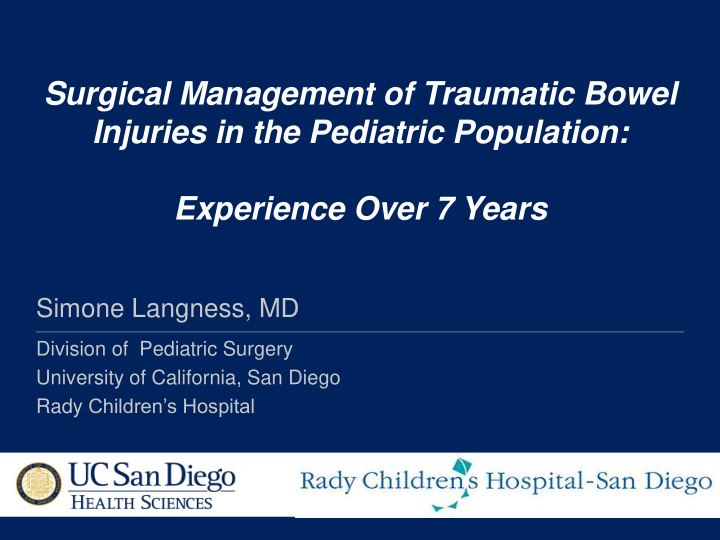



Surgical Management of Traumatic Bowel Injuries in the Pediatric Population: Experience Over 7 Years Simone Langness, MD Division of Pediatric Surgery University of California, San Diego Rady Children’s Hospital
Background • Bowel injuries are rare and varied with respect to severity and mechanisms • Subtle, non-specific symptoms and imaging limitations Delay in diagnosis • Surgical management is diverse and incompletely described Review injury mechanism, surgical management and outcomes after abdominal trauma
Methods • Retrospective review of patients >4 years old who underwent operative intervention suspicion of bowel injury from 2006-2013 • Data evaluated: • Demographics • Injury mechanism • Time to operation • Procedure performed • Outcomes
Results 8,499 Trauma Patients 60 Trauma 8 (13.3%) No Injuries Laparotomy/Laparoscopy 3 (5.0%) Spleen 7 (11.7%) Kidney 5 (8.3%) Liver 2 (3.3%) Pancreas 4 (6.7%) Diaphragm 1 (1.7%) Bladder 34 (55.0%) Bowel Injuries
Isolated Bowel Injuries: Patient Characteristics Demographics Age (years), Average +/- SD 7.7 +/- 3.2 Male, N (%) 19 (57.6) Mechanism of Injury, N (%) Penetrating (GSW, Stab, Other) 4 (11.8) Motor Vehicle Collision 14 (41.2) Bicycle Accident 7 (20.6) Pedestrian vs. Auto 3 (8.8) NAT 3 (8.8) Fall 2 (5.9) Assault 1 (2.9) Injury Severity ISS, Average +/- SD 18.8 +/- 16.9
Blunt Abdominal Trauma: Presentation & Imaging Presenting Symptoms Imaging Findings Pain 73.3% Free Fluid 56.7% Ecchymosis 40.0% Bowel Wall Thickening 30.0% Distension 20.0% Pneumoperitoneum 23.3% Seatbelt Sign 16.1% Mesenteric Bleed/Edema 20.0% 17 (57%) Exploratory Laparotomy 13 (43%) Observation 8 (38.5%) Dx Laparoscopy 5 (61.5%) Exploratory Laparotormy
Delayed Operative Group (>4 Hours) Reason for Operative Exploration Persistent Pain 9 (69.2%) Fever 4 (30.8%) Labs (Leukocytosis 4 (30.8%) or Bandemia) Emesis 2 (15.4%) free fluid, bowel enhancement Tachycardia 1 (7.7%) free fluid Imaging Changes 4 (30.8%) free fluid, dilated loops of bowel free fluid, bowel wall thickening
Injury Location Duodenum 10% 53 bowel injuries identified in 34 patients: Colon 30% 1 Injury: 18 (52.9%) 2 Injuries: 13 (38.2%) 3 Injuries: 3 (8.8%) Jejunum/Ile um Cecum 51% 9%
Injury Location Primary repair 1 (20%) Resection + 1 o Anastomosis Perforation 5 (100%) Duodenum 4 (80%) 10% *None required pyloric exclusion or Roux-en-Y Colon 30% Jejunum/Ile um Cecum 51% 9%
Injury Location Serosal Tear 2 (7.4%) Oversew 2 (100%) Duodenum 10% Primary Repair 3 (20%) Perforation 15 (55.6%) Resection + 1 o Anastomosis Colon 30% 9 (60%) Resection + Ostomy 2 (13.3%) Resection + TAC 1 (6.7%) Mesenteric Defect Primary Repair 2 (40%) Jejunum/Ile 5 (18.5%) Cecum um 9% 51% Mesenteric Vessel Ligation 1 (20%) Hematoma/Bleeding 5 (18.5%)
Injury Location Duodenum 10% Colon 30% Resection + Ostomy 1 (50%) Primary Repair 1 (50%) Perforation 2 (40%) Jejunum/Ile um 51% Oversew 3 (100%) Serosal Tear 3 (60%) Cecum 9%
Injury Location Mesenteric Vessel Ligation 1 (50%) Hematoma/Bleeding 2 (12.5%) Duodenum Resect + Ostomy 10% 1 (33%) Colon Mesenteric Defect Primary Repair 2 (66%) 30% 3 (18.8%) Resection + TAC 1 (25%) Primary Repair 3 (75%) Perforation 4 (25%) Jejunum/Ile Oversew 7 (100%) Serosal Tear 7 (43.7%) um Cecum 51% 9%
Outcomes After Isolated Bowel Injury OR < 4 Hours OR >4 Hours Total N=21 N=13 N=34 Time to OR (hours), Avg +/- Sd 2.0 +/- 0.9 17.9 +/- 5.3 7.8 +/- 8.3 LOS (days), Avg +/- SD 19.6 +/- 26.0 12.3 +/- 17.6 16.9 +/- 23.3 Time to Full Feeds (days), Avg +/- SD 9.8 +/- 8.1 8.3 +/- 7.1 9.2 +/- 9.3 Operative Repair Primary Repair 7 (33.3) 6 (46.2) 13 (38.2) Resection + 1 o Anastomosis 5 (23.9) 3 (23.1) 8 (23.5) Resect + Ostomy 3 (14.3) 1 (7.7) 4 (11.8) Resect + TAC 3 (14.3) 1 (7.7) 4 (11.8) Complications 3 (14.3) 2 (15.4) 5 (14.7) Death 1 (4.8) 0 (0) 1 (2.9)
Conclusions • Bowel injuries after abdominal trauma is rare and the most common symptom is persistent pain • Injuries can be managed safely with primary repair or segmental repair in the majority of cases • Need for complex repairs (ostomy, TAC) increases with severity of mechanism • Unchanged regardless of timing of surgery
Acknowledgements Katherine Davenport, MD Timothy Fairbanks, MD Julia Grabowski, MD
Recommend
More recommend